Welcome to the fascinating world of software development, where things can get a little lost in translation. You see, it’s a place where people who seem to be speaking the same language often need an interpreter, bridging the gap between “normal” language and the technical jargon of IT specialists. And boy, does it lead to a lot of confusion!
A popular source of bewilderment is the difference between Ruby and Ruby on Rails. These terms are thrown around so casually that it’s easy to assume they’re interchangeable. However, in reality, Ruby and Ruby on Rails are not the same thing.
Broadly speaking, the main difference is that Ruby is a scripting language, and Ruby on Rails (also called RoR or Rails) is a web application framework that extends Ruby language. Both are popular and used for various programming tasks and solutions.
Now, let’s dive into more detail regarding what each tool does, its use cases, and its inner workings.
What is Ruby?
Ruby is an open-source, object-oriented scripting language. Unlike other general-purpose programming languages, such as Python or JavaScript, Ruby allows function creation with just a few lines of code. It also does not require a compiler since it runs within a pre-installed program.
When Ruby was created, no other language could provide both the intuitiveness of functional programming and the efficiency of imperative programming.
Ruby programming language is special in that it is:
- Cross-platform;
- Object-based;
- Modular;
- Dynamically typed;
- Flexible in terms of implementations.
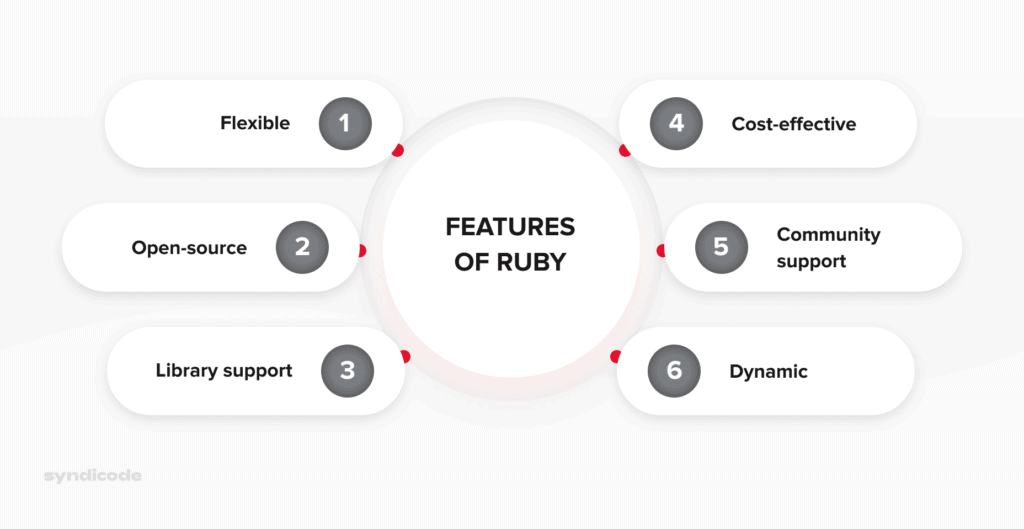
Why use Ruby?
Ruby is a programming language that’s amazingly flexible. Thus, a fantastic Ruby gem Jekyll enables websites to generate all their pages simultaneously. That makes them fast, secure, efficient, and easy to deploy. These factors make Ruby perfect for static websites whose content doesn’t change frequently.
Ruby is also widely used to create web servers since it supports libraries that give high-level access to application-level network protocols.
In addition, due to the many libraries, this language makes the development of automation tools fast and easy. That, in turn, makes it work great for DevOps tasks.
Ruby also comes with built-in functions that can solve many data-processing problems.
Finally, Ruby makes extracting data from web pages a piece of cake, which is helpful for data analysis and parsing tools.
The main strengths of Ruby include the following:
- Dynamic programming, which makes it more similar to a spoken language than programming languages;
- Simple syntax;
- Libraries that help extend and customize the capabilities of the language;
- Easy Rails migrations;
- High-level security covering the OWASP Top 10 list.
At the same time, database connections can significantly slow down Ruby applications’ performance. Moreover, Ruby strictly follows standards and paradigms, which makes it hard to change the core codebase. Finally, documentation is not always up to date, requiring a developer to regularly re-check for essential functionality.
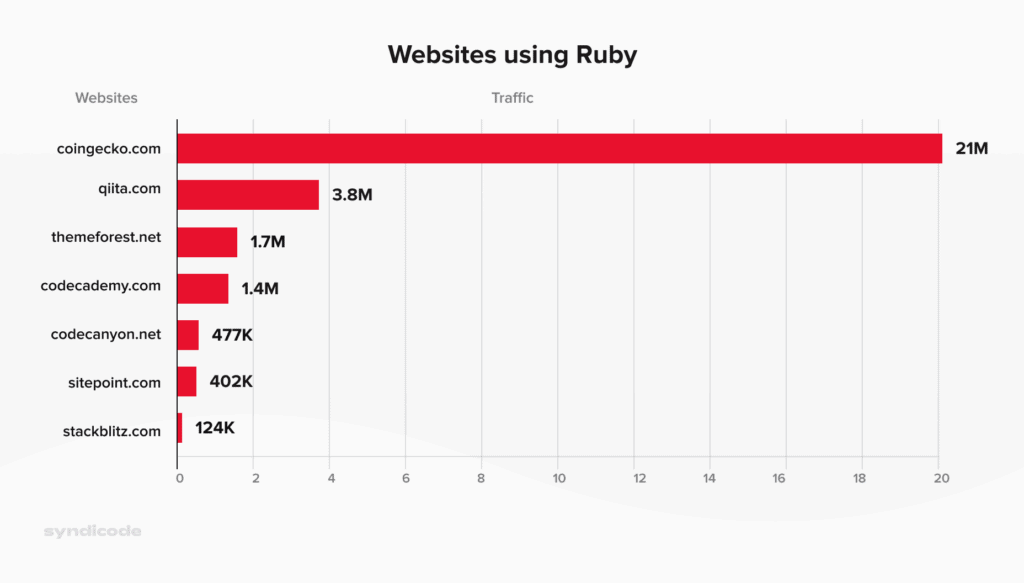
Why learn Ruby?
Ruby remains one of the top popular programming tools. So, if you’re considering getting to the top of the development career or becoming a software architect, you’ll have to learn it along the way.
Another reason to learn Ruby is that the industries with the highest demand for Ruby are among the biggest in the market:
- Retail and eCommerce;
- High tech (VR, AI, autonomous vehicles, solar energy, etc.);
- Financial services;
- Healthcare;
- Entertainment;
- Real estate.
Moreover, Ruby programmers are among the highest-paying professionals in the IT industry. Ruby is also relatively easy to learn as its syntax is similar to spoken language. It is a general-purpose language, meaning you can theoretically use it to create any computer program.
On top of that, the program is open-source and free to use, with a vast community focused on web development.
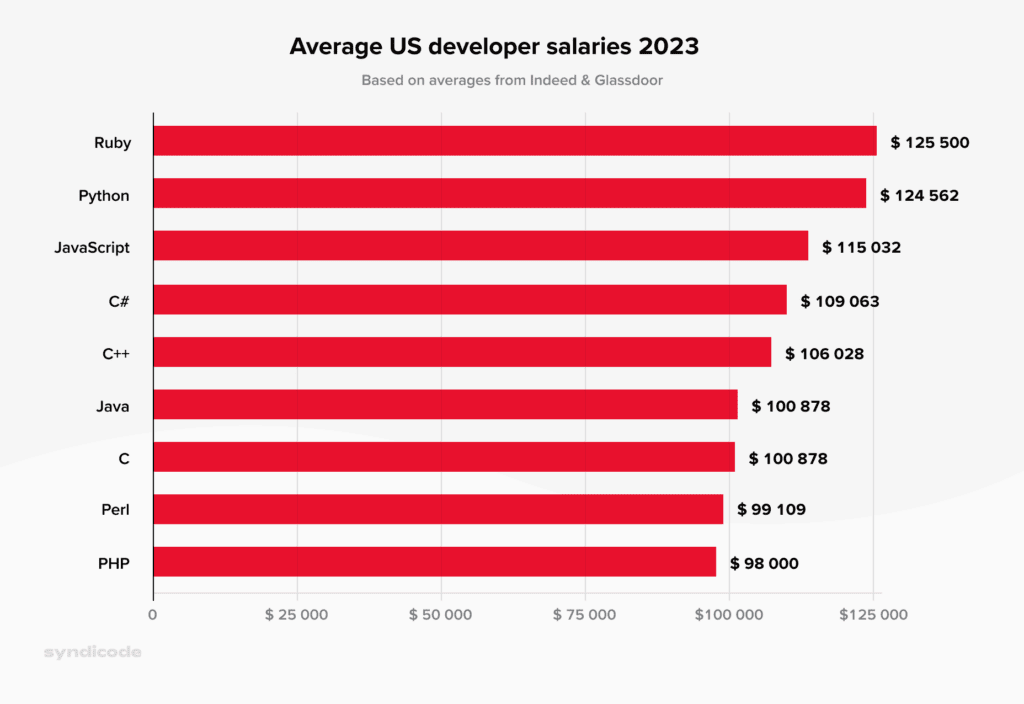
What is Ruby on Rails?
Ruby on Rails (or Rails) is an open-source server-side web application framework written in Ruby. In other words, it is a kind of code library that simplifies programming. But how does Ruby on Rails work?
Well, think of it as a collection of pre-written templates you can mix and match to create an email response quickly. Similarly, a web app framework enables a developer to focus on what a function can do instead of how to write it, thus increasing development speed.
Although it doesn’t have “finished” functions like a regular library, it provides the flow and shows the programmer what else should be done to obtain the desired result.
The Ruby on Rails history started in 2003 when Danish programmer David Heinemeier Hansson merged the capabilities of the Ruby language with the Model-View-Controller (MVC) architecture, which is the crucial feature of Rails. Thus, the Rails framework further sped up the development process with Ruby and simplified code maintenance. Ruby, in its turn, extended Rails with even more pre-built features.
The key characteristics of Ruby on Rails are:
- MVC pattern;
- Front-end tools support;
- Easy developer onboarding;
- Integrated testing tools;
- Automated deployment.
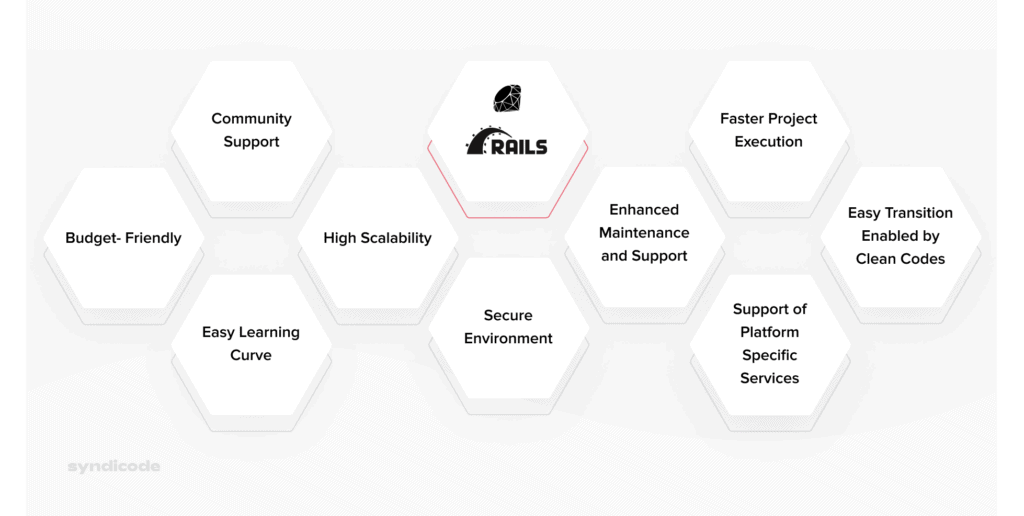
Why use Ruby on Rails?
Ruby on Rails development allows one to create high-performance web platforms quickly. It is suitable for various programming tasks, but most often, developers choose RoR for:
- E-commerce projects due to its unique interface-centric implementation, which is crucial for customer experience;
- Informational portals since the MVC pattern in Ruby on Rails makes it easy to create high-quality software architecture and structurize information;
- Stock exchange platforms since Ruby on Rails has built-in security mechanisms;
- Dating websites due to high compatibility with front-end frameworks;
- Social networks such as Ruby on Rails have an integrated WebSocket implementation;
- SaaS solutions owing to the framework’s modularity and extensibility of applications;
- MVPs due to fast implementation;
- Non-standard complex solutions because of RoR’s robustness and ease of use.
However, the framework has limitations, so using Ruby on Rails isn’t recommended in certain cases. For instance, the boot speed is not among its strongest points, so if it’s crucial for your project, we’d recommend Go or Node.js.
Also, database development with Ruby on Rails requires substantial knowledge due to the abundance of gems.
What can you do with Ruby on Rails?
Many back-end web development tasks require knowledge of Ruby on Rails. Here are some junior developer position duties that RoR can help with:
- Creating templates to generate web pages for the front end;
- Writing server-side code;
- Writing web services that return JSON for Javascript-based front-end solutions.
Ruby on Rails is a popular web framework for startup projects because it enables rapid development and flexibility.
However, big companies use it too. Some best-known brands that leverage the RoR technology are:
- Crunchbase;
- Airbnb;
- Etsy;
- Shopify;
- Github.
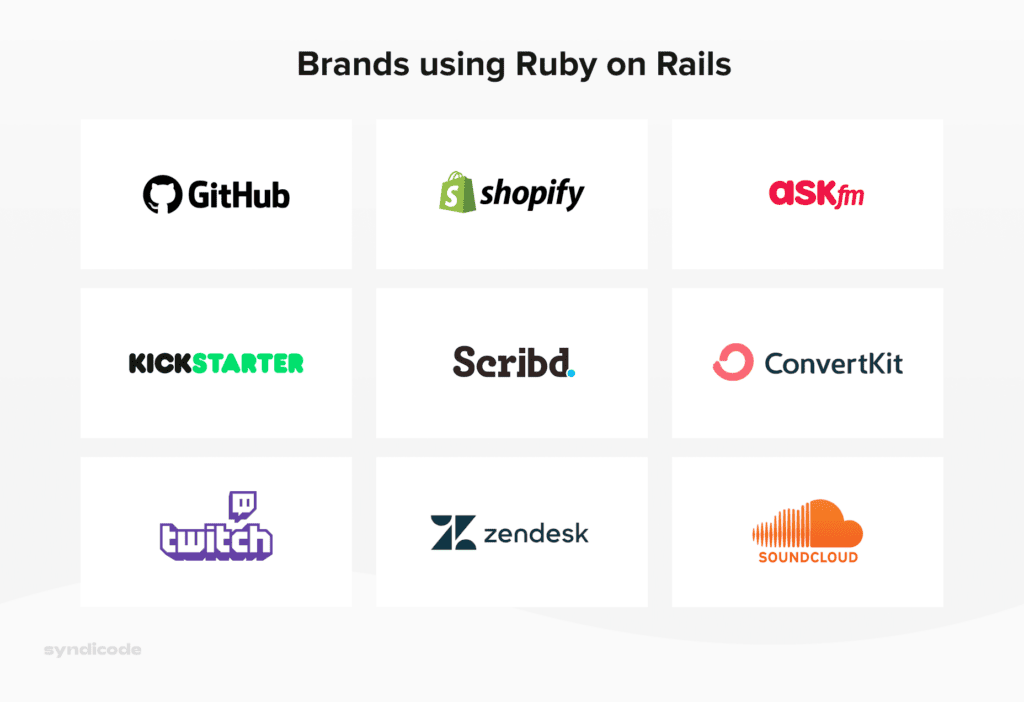
Ruby vs. Ruby on Rails: the similarities
You already know that Ruby is at the heart of the Ruby on Rails framework. Hence, the latter has inherited many of the former’s benefits. The most important are listed below.
Syntax
Both Ruby and Rails aim to simplify the coding process. Ruby’s syntax is clean, with a focus on readability. The language also allows much freedom, enabling developers to indent the code wherever necessary.
The Ruby on Rails syntax additionally eliminates the need to write the same lines twice and prevents script clattering. At the same time, the framework throws warnings about possible errors but doesn’t restrict anything.
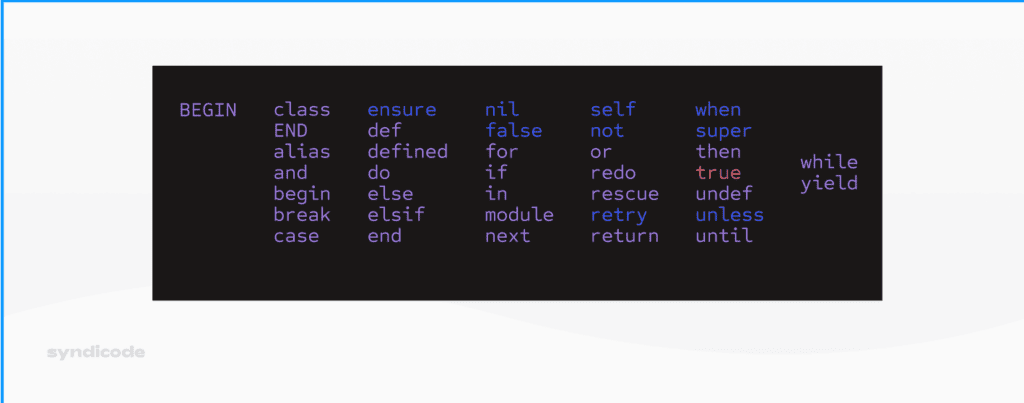
License
Ruby and Ruby on Rails are open source and are free to use and distribute. It means anyone can access and customize the source code to meet their needs. Then, the resulting structure can be distributed freely as well.
In fact, Ruby on Rails might have never appeared if Ruby wasn’t open source.
It also means they both have vast and supportive communities that help drive innovation. As a result, there are ready-made structures (gems) for almost any occasion.
The key differences between Ruby vs. Rails
The introduction of Rails has substantially changed how Ruby has been perceived in the development world. Below is the comparison of Ruby vs. Ruby on Rails in detail.
Scripting language vs. web development framework
Ruby is a full-fledged language with its own syntax and unique rules. It can tell a computer what to do and how to do it.
In contrast, Ruby on Rails enhances and improves the functionality of the Ruby language by utilizing scripts written by other Ruby developers.
A Ruby on Rails developer must know Ruby to work with the Ruby on Rails framework.
Use cases
While Rails extend Ruby, helping mitigate some of its weaknesses, it also somewhat limits its applications. Thus, if you want to build desktop software, you should opt for Ruby vs. Rails. Rails won’t work in this case since it is a server-side script that mainly runs on a web server.
On the other hand, Ruby on Rails significantly speeds up web app development, MVPs, prototypes, etc.
The Syndicode team leverages the Ruby on Rails vs. Ruby differences to our client’s greatest advantage. One of our recent projects, SwiftComply, has multiple integrations with custom systems. Our engineers used the flexibility of the RoR framework to ensure smooth data transfer between several unique systems.
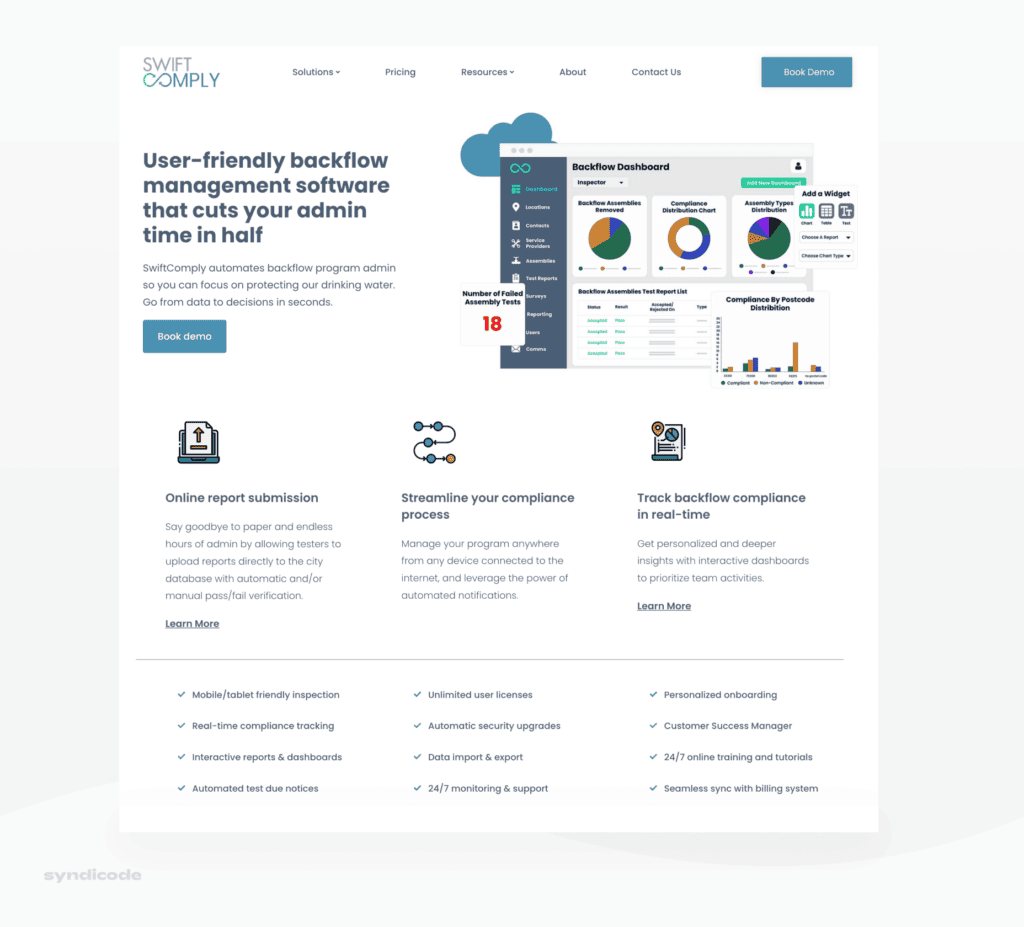
Fuzu is another marketplace we entirely rewrote and optimized for web and mobile. It is loaded with features and uses cutting-edge technologies, which are effectively matched using the capabilities of Ruby and Ruby on Rails.
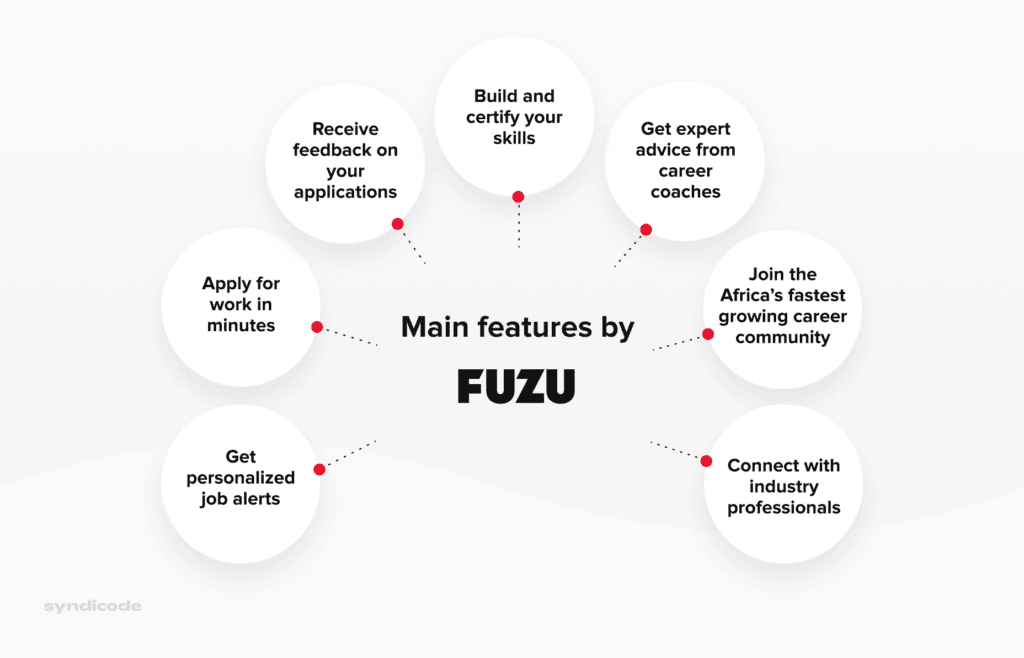
BookYaBike is one more example of the powerful combination of RoR stack and WordPress, creatively implemented by our specialists.
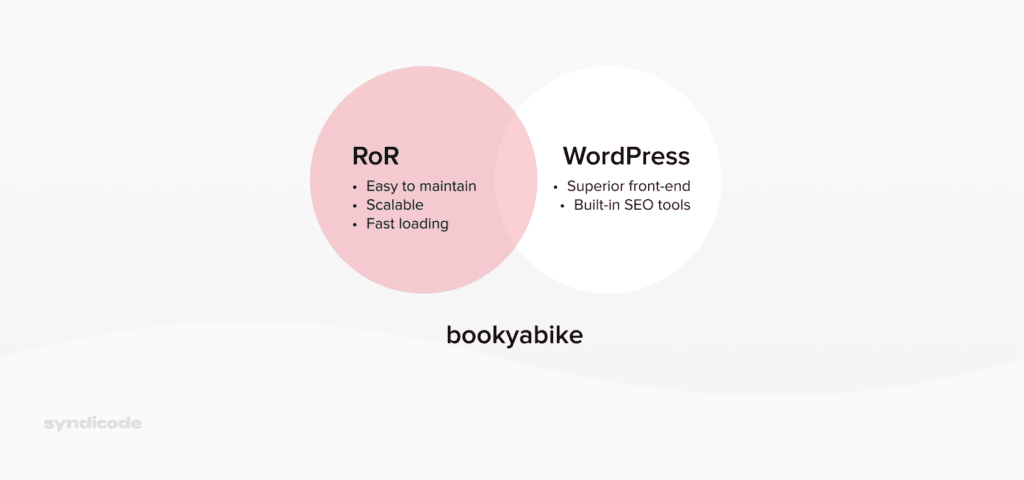
Development specifics
Ruby focuses on user interface design, increasing the developer’s productivity and minimizing work. For instance, it supports block-based code, which allows you to define action parameters and associated data and attach it to many processes simultaneously. This way, you don’t need to retype the code every time the function is executed.
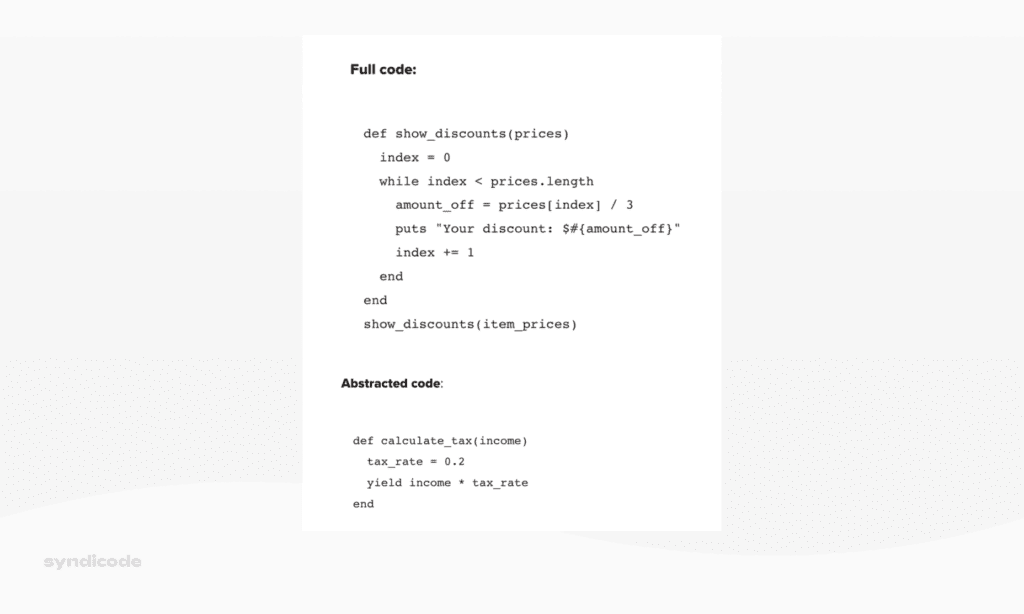
However, Ruby on Rails is based on the principles of DRY (Don’t Repeat Yourself) and CoC (Convention over Configuration). It means that RoR can recover the information from the database by its class name and prevent unnecessary code duplication, tremendously simplifying the developer’s life.
At the same time, the framework enables the developer to specify unconventional aspects of the software product. This way, it is easy to make unique elements that are always present in custom software projects.
Another critical enhancement Rails made to Ruby is the opportunity to use HTML while coding. It extends the framework’s language support and allows utilizing CSS, Java, and XML code.
Ruby vs. Ruby on Rails vs. other tech stacks
Ruby and Ruby on Rails are powerful technologies that speed up development and result in highly robust and dynamic software. However, many other programming languages and frameworks have loyal fans.
Let’s briefly overview the most popular tech stacks and how they differ from Ruby vs. Ruby on Rails.
Ruby and Ruby on Rails vs. Python
Python is a programming language that strives for simple syntax and efficiency. It is compact in its core and can be extended via numerous modules. It’s worth reminding that Ruby on Rails is not a programming language but a framework. The web application framework for Python is called Django.
So, if you were also wondering about the difference between Django vs. Ruby on Rails, that’s your answer. Django helps automate Python development, reducing time to market and overheads. Rails do the same for Ruby development.
Like Ruby, Python is an open-source, clean, readable, high-level back-end language that can create cross-platform web applications.
However, the philosophy behind Python is to find a straightforward way to do a task, making it conservative and less flexible than Ruby. On the other hand, Python works well with big data, which makes it popular for academic uses. As a result, its community focuses on the educational market and academic applications. Ruby is much better suited for commercial purposes in this respect.
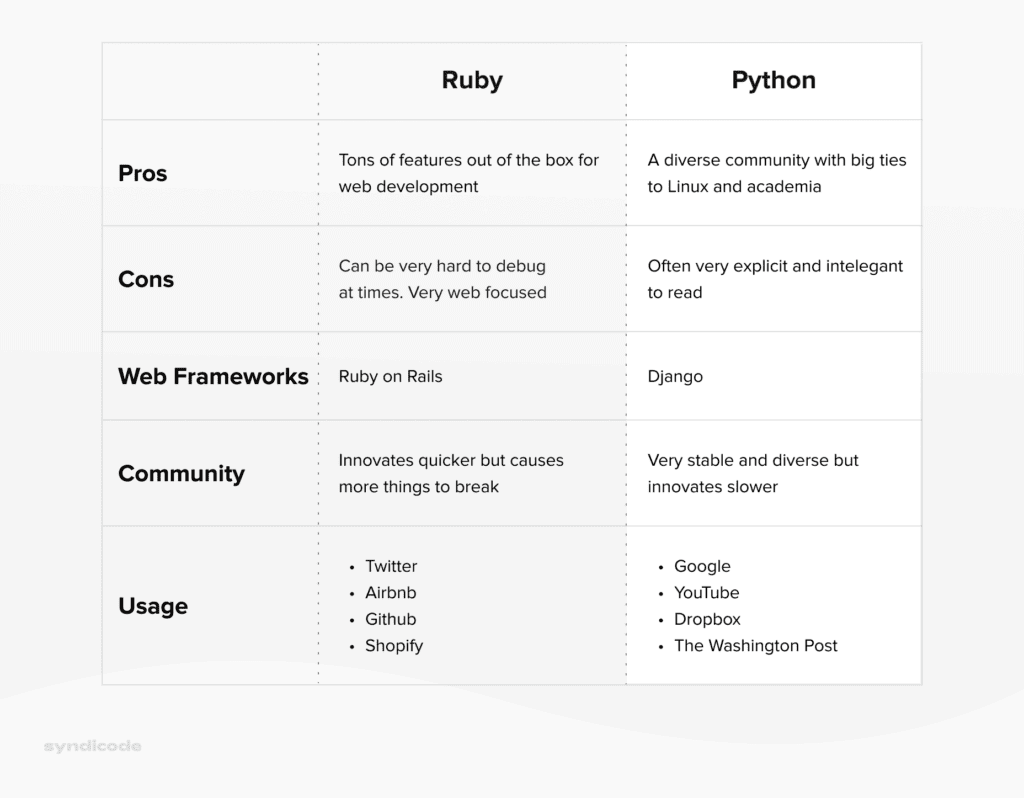
Ruby and Ruby on Rails vs. JavaScript
JavaScript is a high-level scripting language that enables the creation of dynamically updated content. Both JavaScript and Ruby are object-oriented, have a simple syntax, and can be used for the backend.
However, JavaScript is majorly focused on the front end due to its load-balancing functionality, whereas Ruby is strictly back end. Further, JavaScript has a highly optimized engine that makes it faster than Ruby. It also uses fewer servers to provide the same performance level.
On the other hand, Ruby supports Rapid development and can be used for CPU-heavy applications. Thus, you won’t be able to build an image-processing tool with JavaScript since this language can’t monitor memory utilization.
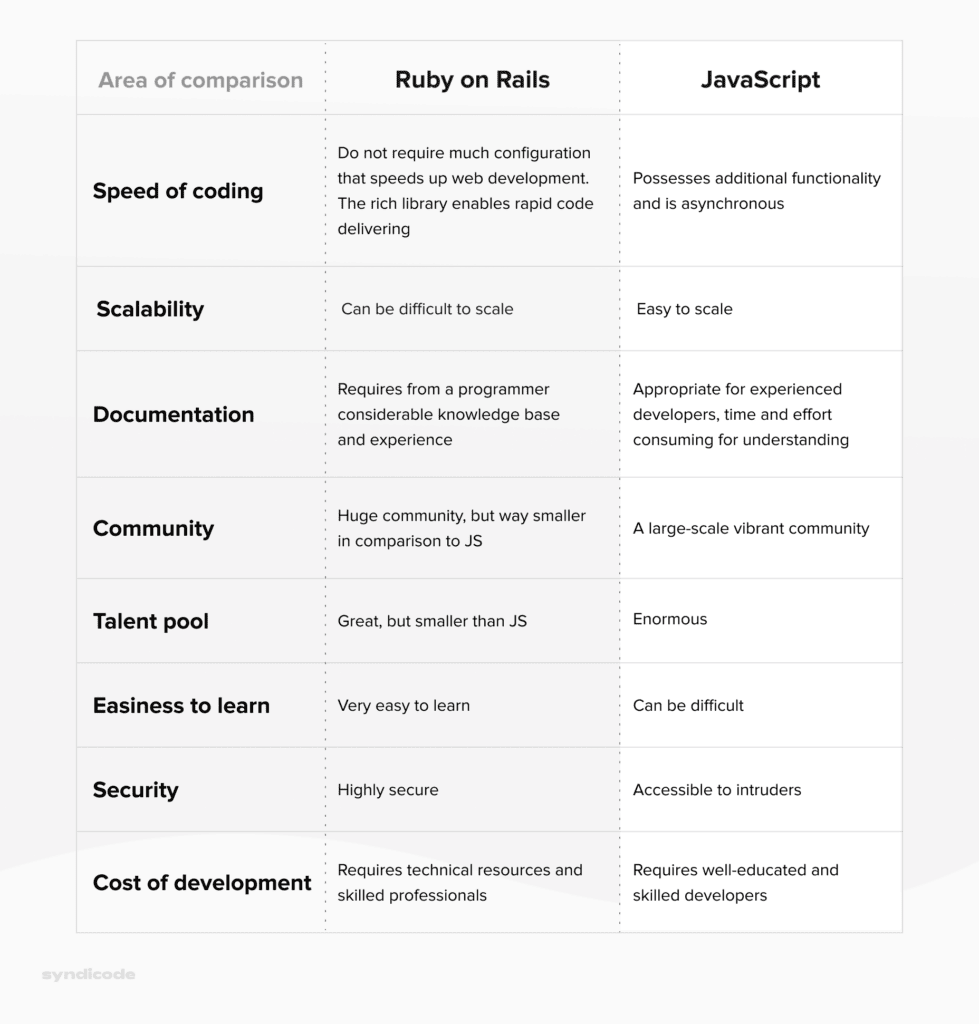
Ruby and Ruby on Rails vs. Node.js
Node.js is a server-side JavaScript framework that enables event-driven programming and simplifies handling concurrent requests. It works only with JavaScript, the first significant difference between Ruby on Rails vs. Node (the former uses Ruby).
The architecture of Node.js enables asynchronous I/O processing, which makes it best suited for IoT solutions, real-time and data-streaming applications, and collaborative tools. Also, Node.js development is well-suited to withstanding high-peak loads.
However, due to multithreading, Ruby on Rails is more suitable for CPU-intensive applications. Also, Node.js isn’t the best choice for Rapid application development (RAD) since it’s time-consuming due to the absence of rules and fewer libraries. At the same time, Ruby on Rails works great in this case.
It’s worth noting that there are more subtle differences between Ruby on Rails vs. Node.js, so you must request a consultation for your project before you decide on the tech stack.
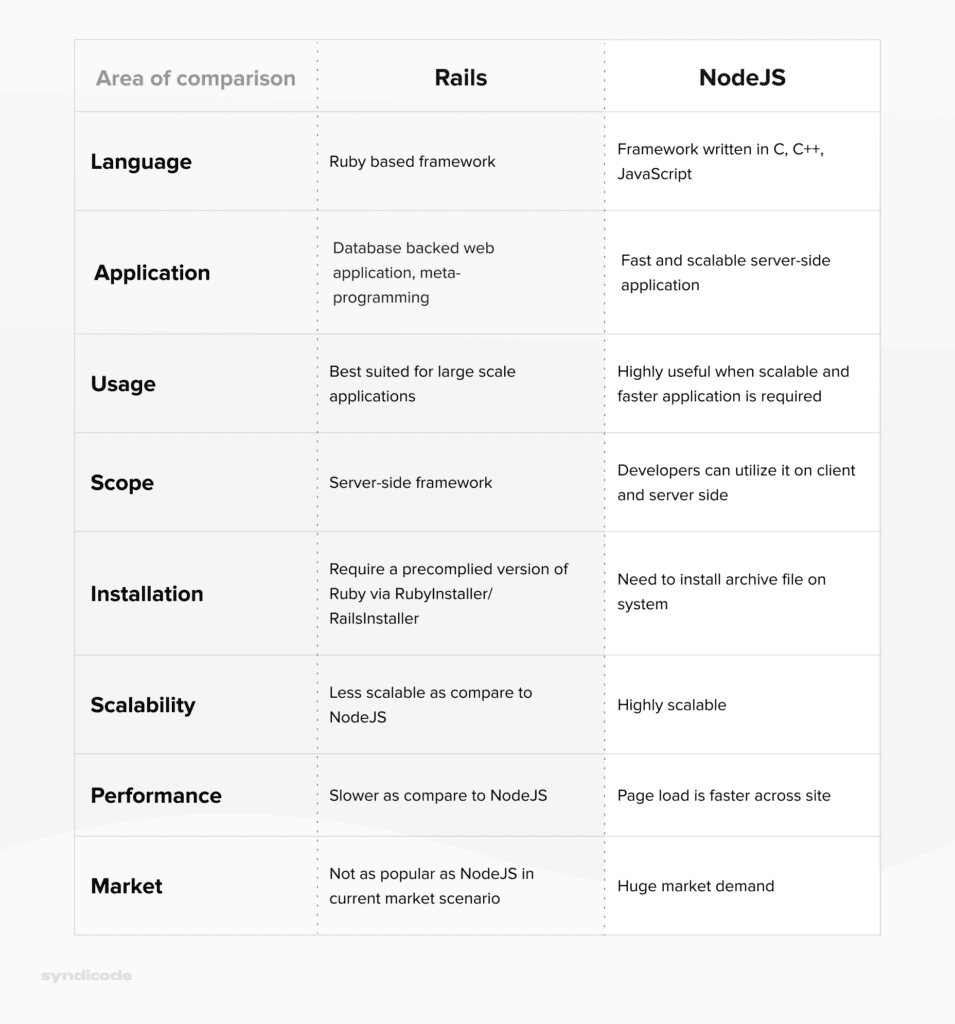
Ruby and Ruby on Rails vs. Go
Go (sometimes called Golang) is a general-purpose programming language designed by Google. It focuses on handling large and complex databases without slowing down performance.
Ruby and Go share a simple syntax and an open-source license. The significant difference between Go vs. Ruby on Rails is that Go is compiled into machine code, making it faster than Ruby. It is also a statically typed language that reduces the likelihood of runtime errors.
On the other hand, being a dynamically typed language, Ruby eliminates the compilation step, shortening the debug cycle. It also encourages a developer to concentrate on logic rather than semantics.
Then again, Go makes it easier to work with relational databases than Ruby. Ruby outplays this by being more tolerant to change than Go.
The comparison makes it easy to grasp why both languages have their share of popularity. We’ll just say that Go is an excellent choice for large software systems. But if you’re a startup, why not use Ruby on Rails? It will give you the necessary speed and the space for innovation.
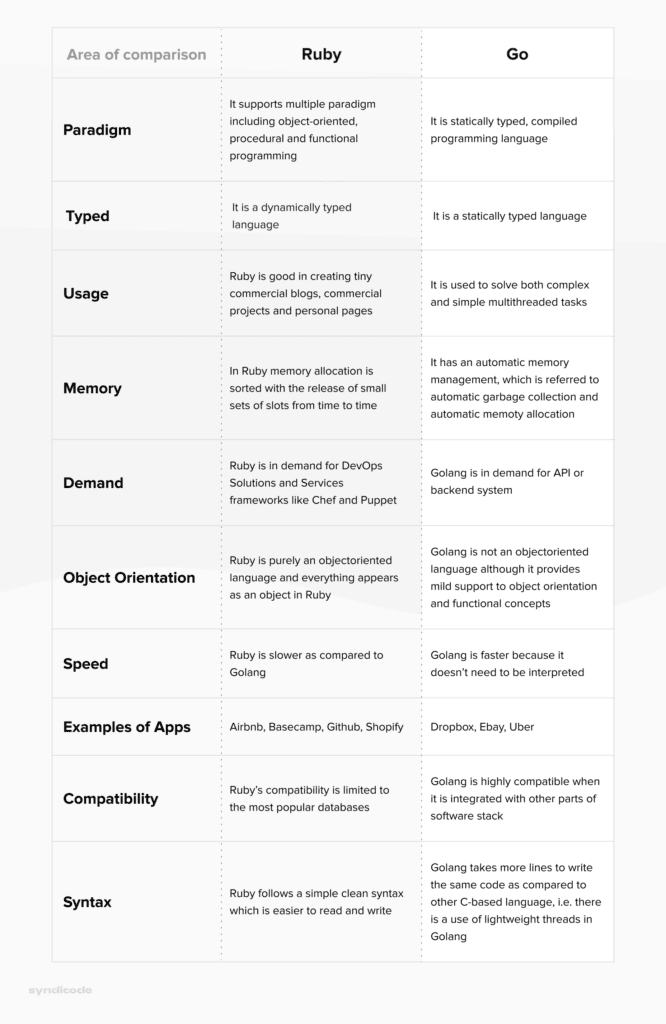
Ruby vs. Ruby on Rails: Syndicode’s choice
The Syndicode engineers are proficient at Ruby on Rails and have built many projects using it in various stack combinations. We love this framework for its versatility and tolerance for change which are helpful for all-size projects.
Ruby and Ruby on Rails enable us to quickly deliver quality marketplaces, software-as-a-service solutions, web platforms, CRMs, social media sites, and management tools. We use it to promptly launch MVPs and add new functionality, maintain the codebase over the years, and save time and money for a given project. We’ve brought Ruby-powered projects to e-commerce, logistics, e-learning, fintech, healthcare, real estate, and other industries.
Having said that, our software development company can also offer you experts in Node.js, PHP, React.js, and other techs if it’s more suitable for your requirements. However, Ruby on Rails is undoubtedly our favorite.
Summing up
Hopefully, this post has cleared out the mishmash around Ruby vs. Ruby on Rails and helped you to make an informed decision. Let’s highlight some key points:
- Ruby vs. Ruby on Rails are different things;
- Ruby is a simple language to learn and use to build software quickly. Given its database-related performance issues, Ruby is an excellent choice for web servers, DevOps, and data processing and analysis tools;
- Ruby on Rails is a framework used to simplify development further using Ruby;
- Rails enhance some characteristics of Ruby, making it easier to understand and improving flexibility and compatibility with other languages. At the same time, if you want to build desktop applications, you should opt for Ruby alone.
